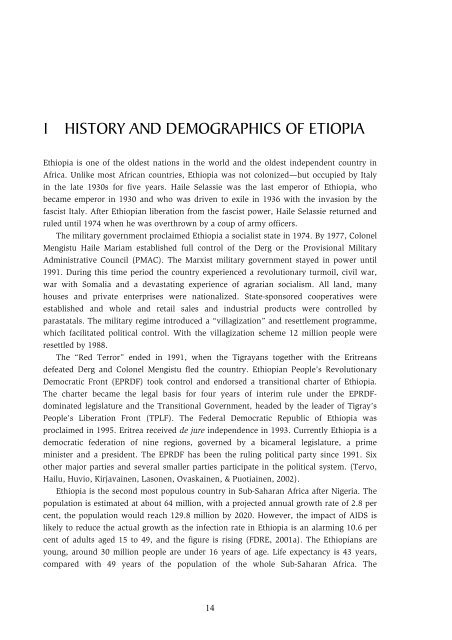Education and Training in Ethiopia An Evaluation of Approaching EFA Goals
Education and Training in Ethiopia - Koulutuksen tutkimuslaitos
Education and Training in Ethiopia - Koulutuksen tutkimuslaitos
- No tags were found...
You also want an ePaper? Increase the reach of your titles
YUMPU automatically turns print PDFs into web optimized ePapers that Google loves.
1 HISTORY AND DEMOGRAPHICS OF ETIOPIA<strong>Ethiopia</strong> is one <strong>of</strong> the oldest nations <strong>in</strong> the world <strong>and</strong> the oldest <strong>in</strong>dependent country <strong>in</strong>Africa. Unlike most African countries, <strong>Ethiopia</strong> was not colonized—but occupied by Italy<strong>in</strong> the late 1930s for five years. Haile Selassie was the last emperor <strong>of</strong> <strong>Ethiopia</strong>, whobecame emperor <strong>in</strong> 1930 <strong>and</strong> who was driven to exile <strong>in</strong> 1936 with the <strong>in</strong>vasion by thefascist Italy. After <strong>Ethiopia</strong>n liberation from the fascist power, Haile Selassie returned <strong>and</strong>ruled until 1974 when he was overthrown by a coup <strong>of</strong> army <strong>of</strong>ficers.The military government proclaimed <strong>Ethiopia</strong> a socialist state <strong>in</strong> 1974. By 1977, ColonelMengistu Haile Mariam established full control <strong>of</strong> the Derg or the Provisional MilitaryAdm<strong>in</strong>istrative Council (PMAC). The Marxist military government stayed <strong>in</strong> power until1991. Dur<strong>in</strong>g this time period the country experienced a revolutionary turmoil, civil war,war with Somalia <strong>and</strong> a devastat<strong>in</strong>g experience <strong>of</strong> agrarian socialism. All l<strong>and</strong>, manyhouses <strong>and</strong> private enterprises were nationalized. State-sponsored cooperatives wereestablished <strong>and</strong> whole <strong>and</strong> retail sales <strong>and</strong> <strong>in</strong>dustrial products were controlled byparastatals. The military regime <strong>in</strong>troduced a “villagization” <strong>and</strong> resettlement programme,which facilitated political control. With the villagization scheme 12 million people wereresettled by 1988.The “Red Terror” ended <strong>in</strong> 1991, when the Tigrayans together with the Eritreansdefeated Derg <strong>and</strong> Colonel Mengistu fled the country. <strong>Ethiopia</strong>n People’s RevolutionaryDemocratic Front (EPRDF) took control <strong>and</strong> endorsed a transitional charter <strong>of</strong> <strong>Ethiopia</strong>.The charter became the legal basis for four years <strong>of</strong> <strong>in</strong>terim rule under the EPRDFdom<strong>in</strong>atedlegislature <strong>and</strong> the Transitional Government, headed by the leader <strong>of</strong> Tigray’sPeople’s Liberation Front (TPLF). The Federal Democratic Republic <strong>of</strong> <strong>Ethiopia</strong> wasproclaimed <strong>in</strong> 1995. Eritrea received de jure <strong>in</strong>dependence <strong>in</strong> 1993. Currently <strong>Ethiopia</strong> is ademocratic federation <strong>of</strong> n<strong>in</strong>e regions, governed by a bicameral legislature, a primem<strong>in</strong>ister <strong>and</strong> a president. The EPRDF has been the rul<strong>in</strong>g political party s<strong>in</strong>ce 1991. Sixother major parties <strong>and</strong> several smaller parties participate <strong>in</strong> the political system. (Tervo,Hailu, Huvio, Kirjava<strong>in</strong>en, Lasonen, Ovaska<strong>in</strong>en, & Puotia<strong>in</strong>en, 2002).<strong>Ethiopia</strong> is the second most populous country <strong>in</strong> Sub-Saharan Africa after Nigeria. Thepopulation is estimated at about 64 million, with a projected annual growth rate <strong>of</strong> 2.8 percent, the population would reach 129.8 million by 2020. However, the impact <strong>of</strong> AIDS islikely to reduce the actual growth as the <strong>in</strong>fection rate <strong>in</strong> <strong>Ethiopia</strong> is an alarm<strong>in</strong>g 10.6 percent <strong>of</strong> adults aged 15 to 49, <strong>and</strong> the figure is ris<strong>in</strong>g (FDRE, 2001a). The <strong>Ethiopia</strong>ns areyoung, around 30 million people are under 16 years <strong>of</strong> age. Life expectancy is 43 years,compared with 49 years <strong>of</strong> the population <strong>of</strong> the whole Sub-Saharan Africa. The14




![to read the full report [pdf, Amharic] - Ethiopian Review](https://img.yumpu.com/52737829/1/190x245/to-read-the-full-report-pdf-amharic-ethiopian-review.jpg?quality=85)











